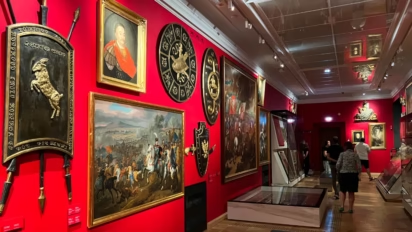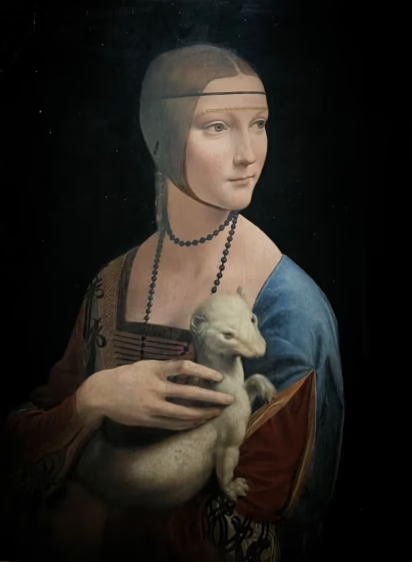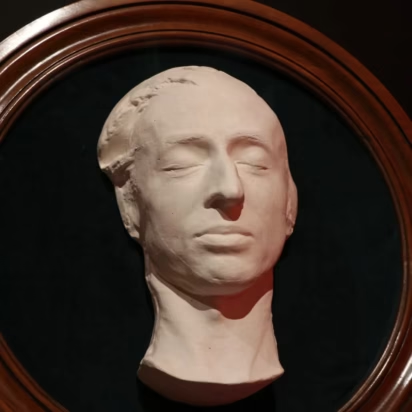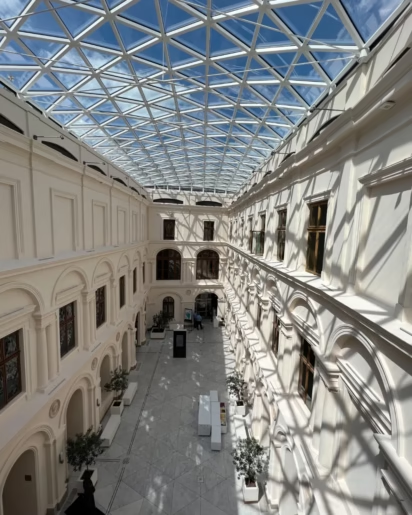Lady with an Ermine by Leonardo da Vinci and a rare Rembrandt landscape painting in the Princes Czartoryski Museum are the top artworks in Krakow and Poland.

The Princes Czartoryski Museum in Krakow (Muzeum Książąt Czartoryskich w Krakowie) is one of the finest art museums in Poland. This exquisite collection with around 3000 items on display is easy to enjoy and contains with the Lady with an Ermine painted by Leonardo da Vinci and the rare Rembrandt’s Landscape with the Good Samaritan two of the most famous paintings in Poland and two works of international renown. Time-slot reservations are essential to visit the museum but are relatively easy to obtain.
Princes Czartoryski Museum in Krakow
The Princes Czartoryski Museum in a city palace in the heart of Krakow is one of the finest art museums in Poland. It is world-famous for Leonardo da Vinci’s painting of the Lady with an Ermine — probably the easiest Da Vinci painting in the world to study without a scrum of crowds (vid. Mona Lisa) or elaborated and expensive reservation requirements (vid. Last Supper). Rembrandt’s Landscape with the Good Samaritan is a further famous work that could be enjoyed at leisure.
The Czartoryski Museum is based on the art collection of the Czartoryski family — a Polish noble family that started to buy quality art in the late 18th century. The history of the family and the collection is quite interesting too but for most visitors, the main thing is that the Czartoryskis had good taste (and money).
Lady with an Ermine by Da Vinci in the Czartoryski Museum in Krakow
The portrait of a Lady with an Ermine by Leonardo da Vinci (1490) in the Czartoryski Museum in Krakow is the most famous and most valuable painting in Poland. This relatively small oil on walnut panel painting measures 54 cm × 39 cm (21 in × 15 in) and is an undisputed Da Vinci — the master’s fingerprints are in the paint.
The painted lady is almost certainly Cecilia Gallerani, the mistress of Ludovico Sforza, Duke of Milan, who used the ermine as his personal emblem. The ermine, a white weasel, is slightly too big to be natural which enhances its symbolic importance. The ermine was also a symbol of purity, moderation, and even vanity while it is also possibly a wordplay on Cecilia (but only for those familiar with Ancient Greek).
Like Da Vinci’s famous Mona Lisa in the Louvre in Paris, the Lady with an Ermine is also displayed behind thick glass. However, in contrast to the Mona Lisa, visitors to the Czartoryski Museum in Krakow will find it relatively easy to study the painting close up at leisure with few, and at times no other visitors in the same room.
The Da Vinci was already around three centuries old when it was acquired by Prince Czartoryski in 1798. It was frequently moved during unrest and wars but returned to Krakow after the Second World War. The other top work in the Czartoryski Collection — Raphael’s Portrait of a Young Man — was lost during the war, although the Polish Foreign Ministry claims it survived.
Rembrandt Landscape Painting in the Czartoryski Museum in Krakow

Rembrandt’s Landscape with the Good Samaritan (1638) in the Princes Czartoryski Museum in Krakow is one of only eight landscapes by Rembrandt and one of only three Rembrandt paintings currently in Polish permanent collections. This oil on oak painting measures 46.2 cm × 65.5 cm (18.1 in × 25.7 in).
In contrast to the Da Vinci painting, the Rembrandt landscape is filled with details only revealed after careful study. Given the pleasantly low visitor numbers in the museum, this is easily done without being an obstruction to others.



The theme of the work is the Biblical parable of the Good Samaritan from the Gospel of Luke. In the far right corner, just above the clear Rembrandt signature, is a half-naked man, who was attacked and robbed, being helped onto a horse by the good Samaritan. Nearby a rich, well-dressed couple looks on in horror having probably witnessed the attack. The role of the hunter with a gun and assistant is less obvious.
Further down the road, to the left of the giant oak tree, is a carriage pulled by four horses, and at the turn of the road, are presumably the priest and Levite that passed the attacked man earlier on without offering assistance.
The landscape is composed of various elements, both local (Dutch flatlands, windmills, stone bridge, farm buildings on the edge of the forest), and exotic (mountains, oriental city with copulas, palm tree in the clearance of the road). On the bright plains, note the small figures of people working in the fields, a fisherman at work, and animals – horses and cows. It is really regrettable that Rembrandt did so few landscapes.
The Royal Lazienki where the picture was on loan in 2019 has a beautiful description of the work.
Non-Da Vinci Works in the Princes Czartoryski Museum in Krakow



Although the Princes Czartoryski Museum in Krakow has over 3000 items on display, the museum is easy to enjoy with only around ten rooms on each of the two main exhibition floors. As the museum is housed in a former city palace, these rooms are not particularly big or overfull but it is the quality and variety of items on display that make visiting the galleries such a pleasure.
Paintings, sculptures, objets d’art, applied arts (military, religious, household utensils), prints, tapestries, costumes, and jewelry blend easily with something to enjoy for every visitor. Descriptions are in both Polish and English and an automatic audio guide is available for visitors keen on more details and context.



The first floor is organized mainly around the history of the Czartoryski family, as well as works closely associated with the reigns of various Polish royal dynasties including the Jagiellonian, Swedish Vasa, and Saxon House of Wettin. A highlight is the Victory of Vienna Room (1683) with trophies brought back by King Jan III Sobieski, including an elaborately embroidered ceremonial tent of an Ottoman commander, and a feathered Hussar uniform (with sound effects). A surprise at the end of the tour here is a few high-quality works from the Far East.
The top floor is more typical European gallery art and is ordered mostly chronologically. A few items from antiquity (the larger antiquities collection is in the separate Arsenal building), Renaissance and medieval art, Northern European art from the 15th to 17th centuries, the Rembrandt period, Leonardo da Vinci, and the Polish room with mostly 19th-century nationalist works. Two final rooms have rotating displays of the vast collection of the library and the cabinet of drawings and prints. (Several by Albrecht Dürer.)
Visitor’s Information for the Czartoryski Museum in Krakow

Opening Hours of the Princes Czartoryski Museum
The Princes Czartoryski Museum in Krakow is closed on Monday and open on other days at 10:00 and closing at 18:00 on Wednesday, Thursday, and Sunday, and at 19:00 on Tuesday, Friday, and Saturdays.
The museum is closed on most religious holidays with shorter hours on other national holidays.
Admission to the Princes Czartoryski Museum is currently around 8 persons every ten minutes and it never becomes the scrum of the Louvre or British museums. As with other museums, early morning and late afternoon are great times to visit but also consider visiting around lunchtime when fewer slots are handed out and the museum is quieter.
Tickets for the Princes Czartoryski Museum
Admission is free on Tuesday — ignore the “Sold Out” signs on the website, online reservations are simply not possible on Tuesdays.
Standard tickets are PLN35 (around €7.50) and include admission to several further small museums within three months. Further combination deals may be available including with the antiquities displayed in the nearby Arsenal. The Krakow City Pass is accepted but time-slot reservations are still required.
Time-slot reservations are free and obligatory (but could be made on-site and for immediate entry if tickets are available) — note that online reservations and payments are often separate processes. In contrast to many other museums in Krakow, online payment of the tickets is required to confirm the reservation — print-at-home tickets or mobile tickets are emailed. Get Your Guide also sells tickets with often better cancelation options but a timeslot reservation is still required.
The Princes Czartoryski Museum, św. Jana 19, 31-017 Kraków, Poland, is around three blocks to the north of the huge market square near St Florian’s city gate.
Krakow
Buy the Krakow City Pass Online — admission to museums and sights
Book Tours and Events in Krakow, Poland:



